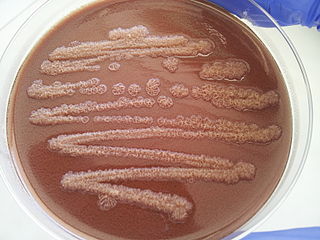Related Research Articles

Halomonadaceae is a family of halophilic Proteobacteria.

Clostridium acetobutylicum, ATCC 824, is a commercially valuable bacterium sometimes called the "Weizmann Organism", after Jewish Russian-born biochemist Chaim Weizmann. A senior lecturer at the University of Manchester, England, he used them in 1916 as a bio-chemical tool to produce at the same time, jointly, acetone, ethanol, and n-butanol from starch. The method has been described since as the ABE process,, yielding 3 parts of acetone, 6 of n-butanol, and 1 of ethanol. Acetone was used in the important wartime task of casting cordite. The alcohols were used to produce vehicle fuels and synthetic rubber.

Pseudomonas stutzeri is a Gram-negative soil bacterium that is motile, has a single polar flagellum, and is classified as bacillus, or rod-shaped. While this bacterium was first isolated from human spinal fluid, it has since been found in many different environments due to its various characteristics and metabolic capabilities. P. stutzeri is an opportunistic pathogen in clinical settings, although infections are rare. Based on 16S rRNA analysis, this bacterium has been placed in the P. stutzeri group, to which it lends its name.
Sphingomonas paucimobilis is a strictly aerobic Gram-negative bacterium that has a single polar flagellum with slow motility. The cell size is around 0.7 x 1.4 μm. It is usually found in soil. As with the other members of the genus, its biochemistry is remarkable in possession of ubiquinone 10 as its major respiratory quinone, and of glycosphingolipids instead of lipopolysaccharides in its cell envelope. It has been implicated in various types of clinical infections.
Alteromonas is a genus of Proteobacteria found in sea water, either in the open ocean or in the coast. It is Gram-negative. Its cells are curved rods with a single polar flagellum.
Lysinibacillus sphaericus is a Gram-positive, mesophilic, rod-shaped bacterium commonly found on soil. It can form resistant endospores that are tolerant to high temperatures, chemicals and ultraviolet light and can remain viable for long periods of time. It is of particular interest to the World Health Organization due to the larvicide effect of some strains against two mosquito genera, more effective than Bacillus thuringiensis, frequently used as a biological pest control. L. sphaericus cells in a vegetative state are also effective against Aedes aegypti larvae, an important vector of yellow fever and dengue viruses.
In taxonomy, Sagittula is a genus of the Rhodobacteraceae.
Acanthopleuribacter is a genus in the phylum Acidobacteria (bacteria).
Afifella is a genus in the phylum Proteobacteria (Bacteria). Afifella are found in marine and estuarine settings, including microbial mats. They are anaerobes, with one cultured representative capable of photosynthesis.
Desulfosporosinus is a genus of strictly anaerobic, sulfate-reducing bacteria, often found in soil.
Campylobacter concisus is a Gram-negative, highly fastidious, mesophilic bacterium that grows under both anaerobic and microaerobic conditions with the presence of hydrogen significantly aiding growth. Motile, with either unipolar or bipolar flagella, the organisms have a characteristic spiral/corkscrew appearance and are oxidase-positive. Although the human oral cavity is the natural colonization site of the bacterium, C. concisus may also colonize the intestinal tract of some individuals. In particular, several studies have reported higher intestinal prevalence of C. concisus in patients with IBD compared to healthy controls, which has led to current speculation of the bacterium's implication in the induction of Crohn's disease.
Brucella anthropi is a bacterium. The type strain is strain CIP 82.115. O. anthropi strains are rod-shaped, aerobic, gram-negative, non-pigmented and motile by means of peritrichous flagella. They are emerging as major opportunistic pathogens.
Salinispora arenicola is an obligate marine actinomycetes bacterium species. It produces salinosporamide, a potential anti-cancer agent. The type strain is CNH-643T.
Prevotella bryantii, previously known as Bacteroides ruminicola ruminicola subsp. brevis biovar 3, is a species of bacterium.
Vibrio pectenicida is a pathogenic bacterium which attacks larvae of the scallop Pecten maximus. This bacterium does not use glucose or fructose as its carbon sources, but instead uses rhamnose and betaine. A365 is the type strain.
Microbulbifer hydrolyticus is a gram-negative, rod-shaped, strictly aerobic bacteria, the type species of its genus. It was first isolated from lignin-rich pulp mill effluent. Its type strain is IRE-31.
Opitutus terrae is an obligately anaerobic bacterium first isolated from rice paddy soil, hence its epithet. It is coccus-shaped and is motile by means of a flagellum. Its type strain is PB90-1T. Its genome has been sequenced.
Shewanella sediminis is a hexahydro-1,3,5-trinitro-1,3,5-triazine-degrading bacterium from marine sediment. It is psychrophilic and rod-shaped, with type strain HAW-EB3T.
Tsukamurella tyrosinosolvens is a Gram-positive and aerobic bacterium from the genus of Tsukamurella. Tsukamurella tyrosinosolvens bacteria can cause in rare cases infections in humans.
Rapidithrix thailandica is a bacterium from the genus of Rapidithrix which has been isolated from the coastline from the Andaman Sea in Thailand. Rapidithrix thailandica produces an antibacterial amino phenyl pyrrolidone.
References
- ↑ Gonzalez, J. M.; Mayer, F.; Moran, M. A.; Hodson, R. E.; Whitman, W. B. (1997). "Sagittula stellata gen. nov., sp. nov., a Lignin-Transforming Bacterium from a Coastal Environment". International Journal of Systematic Bacteriology. 47 (3): 773–780. doi: 10.1099/00207713-47-3-773 . ISSN 0020-7713. PMID 9226910.